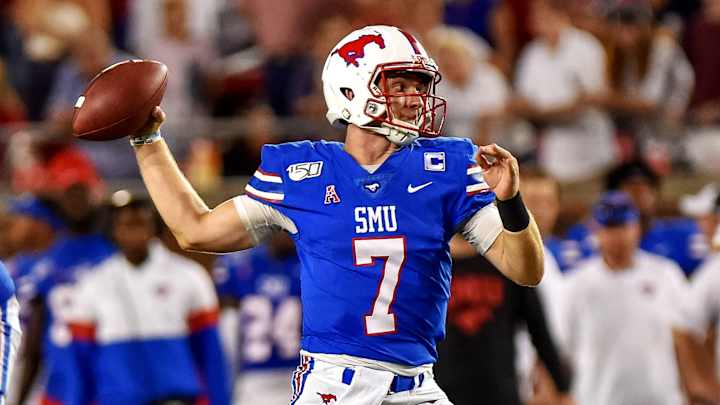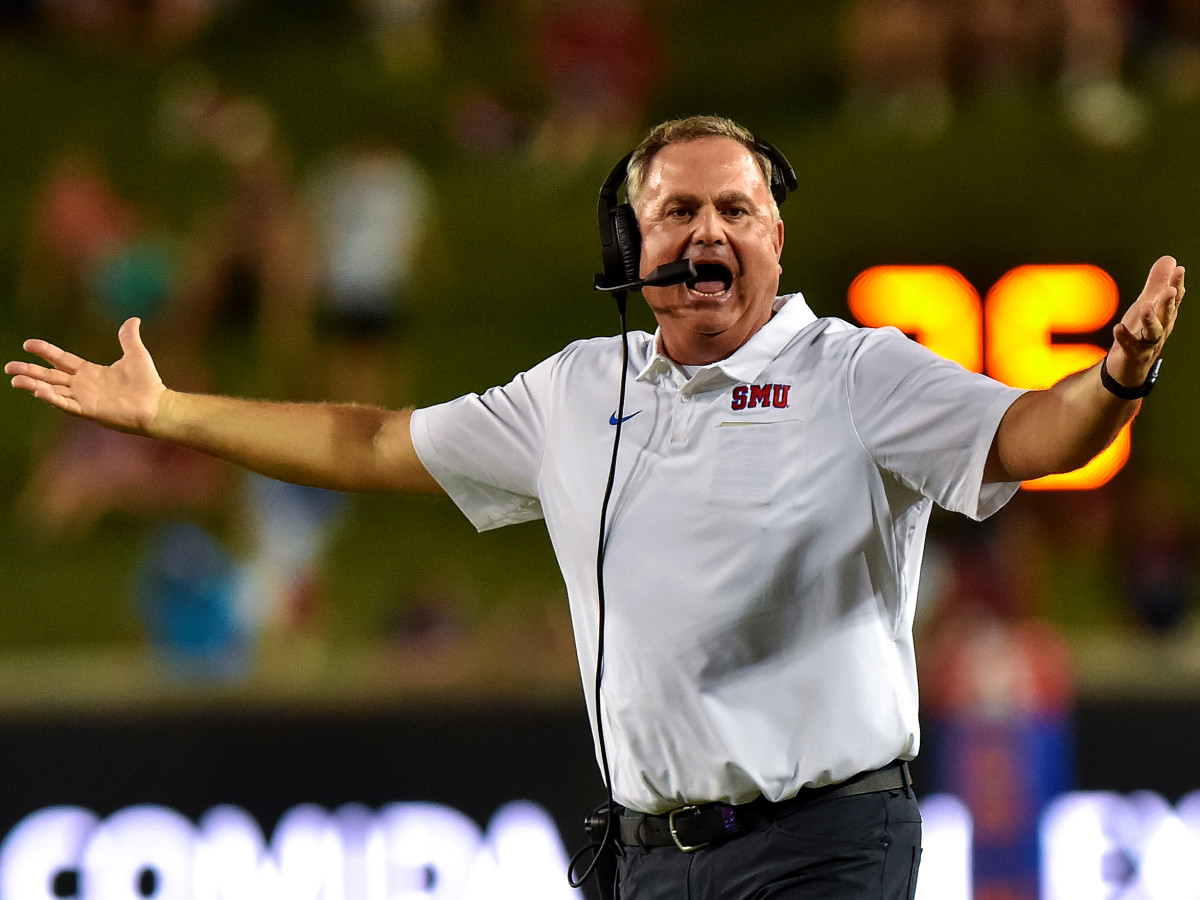What's Behind SMU's Surprising Resurgence?


DALLAS — Shane Buechele didn’t know much about the Death Penalty when he came to SMU. Neither did James Proche. Or a lot of their other teammates. The extent of their knowledge came from what they’d seen on TV.
“It’s not really discussed,” Buechele says. “We don’t really care much about it.”
SMU was sentenced in 1987. None of the current players had been born yet and got most of their information about the Death Penalty by watching the 30 for 30 film, ‘Pony Excess.’ These guys grew up just knowing the Mustangs were a struggling program—over the past three decades, they’ve had only five winning seasons and zero 10-win seasons. The current team just wants to focus on building a winning program.
And that’s what they’re doing. The Mustangs are one of the biggest surprises of this college football season. They’re off to a perfect 8-0 start for the first time since 1982, ranked No. 15 in the AP Poll, and have a chance to play in a high-profile bowl game. While they don’t have a realistic shot at the College Football Playoff, the highest-ranked Group of Five conference champion will play in a New Year’s Six bowl game. (This year, the Cotton Bowl—located about 25 miles west of campus—happens to be hosting the at-large team.) SMU still has big games left on the schedule, most notably a visit to No. 25 Memphis on Saturday, which is also the site for College GameDay.
But to understand SMU’s success now is to also appreciate some history—and irony. In the 70s and 80s, SMU identified a popular trend in the market: to pay its players. The NCAA had never suspended a football program before, but SMU earned it. The Mustangs weren’t just caught breaking rules—a booster was found to have paid players from a slush fund with approval from members of the athletic staff—they were breaking rules while already on probation for recruiting violations. “We weren’t doing anything different than Arkansas, Texas A&M or any of the other Southwest Conference schools,” says former SMU quarterback Lance McIlhenny, who played from 1980-83. But the Ponies were the best at it and got caught. The Death Penalty shut the program down for two years, and for decades afterward, it looked like it might never recover.
But in sports, everyone likes a good comeback story. More than 30 years later, SMU is doing things differently. It has not only identified a new market trend that’s helping it return to national prominence, it’s full on embracing it. And this time it’s legal.
College football teams like SMU are getting smart and approaching the sport’s landscape in a similar way. The transfer portal, a database of players in any college sport who have interest in transferring, is available to every program. And since its advent in October 2018, it’s changed college football. Some schools are taking advantage of it.
While the blockbuster transfers of last offseason included Oklahoma snagging Jalen Hurts and Ohio State adding Justin Fields, SMU has quietly figured out how to rebuild its program by utilizing this NCAA tool. There are 60 new names on this year’s roster, including 16 transfers, which is at least four more than any other team. It’s an impressive group that includes quarterback Shane Buechele, who is from Arlington and started his career at Texas but lost his starting job to Sam Ehlinger, and the team’s No. 1 receiver Reggie Roberson Jr., who is from Mesquite and played in every game as a freshman at West Virginia. With the exception of starting defensive tackle Zach Abercrumbia, every transfer has multiple years of eligibility remaining.
“We’ve become Transfer-U in a weird sort of way,” SMU head coach Sonny Dykes says.
But what’s the players’ incentive to come to SMU?
“It’s Dallas,” Proche says, who is from DeSoto. “You can come here and play right away. There aren’t a lot of people you have to wait behind. There are opportunities here. A lot of people come to get their Masters and a degree from SMU holds a lot of weight.”

Dykes has always had a strong connection to SMU. His dad, Spike, was legendary in Texas and spent the majority of his 40-year career coaching high school and college ball in the state, including as an assistant for Darrell K. Royal. When Spike later took jobs at New Mexico and Mississippi State, a young Sonny wanted to adopt a Texas team to cheer for. He picked SMU because “they were really good,” he says, reminiscing about the ‘Pony Express’ teams and its flashy backfield of Craig James and Eric Dickerson. And, he liked their uniforms. “For some reason, when you’re young, you pick a school and stick with it,” Dykes says. After graduating from Texas Tech, Dykes got his first assistant coaching job at J.J. Pearce High School in Richardson, a suburb of Dallas. In his free time, he’d drive south to SMU’s campus and think, “Man, this is beautiful and what a cool place to go to school. I’d love to coach here someday.”
He got that opportunity in 2017, after getting fired from Cal where he went 19-30. Dykes returned to the Hilltop with ideas of how to market and brand SMU to compete with Power 5 programs. He wanted his team to be synonymous with Dallas, be known as Dallas’ team. “I always felt the key to SMU’s success would be to get Dallas kids to stay here,” says Dykes, who recruited the Dallas-Fort Worth area when he was an assistant at Texas Tech. It started by bringing players home—much like his own homecoming—by landing transfers from the area who began their careers elsewhere but wanted to return. Of the 16 transfers in 2019, 11 are from the Dallas-Fort Worth metroplex. The athletic department also put up billboards in the towns of local players to encourage high school kids to consider SMU. They feature a photo of a player with the words “Pony Up,” followed by that player’s hometown, like Cedar Hill or Oak Cliff or Highland Park. And they changed their uniforms to say ‘Dallas’ on the chest instead of SMU and put a city logo on their helmet.
“We’re not Power 5 and there’s a label associated with that,” Dykes says. “The thing we try to tell [players] all the time is, why would you leave here to go to Minneapolis or Stillwater or Lubbock when you can stay close to home, play good football, live in Dallas, and get all the academic, internship and business opportunities? Why would you go to those places and freeze your tail off? Stay here and play winning football in front of your friends and family.”
Buechele noticed that when he transferred. As a former four-star prospect out of Arlington (Texas) High School, a 30-minute drive from SMU, Buechele saw a career path. He knew Dykes’ history coaching quarterbacks like Jared Goff at Cal and Nick Foles at Arizona. And he was intrigued by the opportunity to play with guys he knew of from high school or football camps.
“It’s a really cool thing having guys all from the DFW area,” Buechele says. “We went different places and all ended up back here where we’re from. We didn’t know each other, but it’s like we did because we’re from the area and that’s helped bring us closer together.”
There’s still a long way to go to sustain success. And eventually Dykes hopes to get the Shane Buecheles of the world out of high school instead of a year or two later. But right now, this is working. The Mustangs are winning. And attendance is up. In 2011, less than half of the 32,000-seat Gerald J. Ford Stadium was filled for Senior Day. A few weeks ago, more than 28,000 fans showed up to see SMU beat Tulsa in triple overtime. And the next Saturday, more than 23,000 fans watched the Mustangs beat Temple.
Clearly, this is a new era of SMU football, one that’s still built on taking advantage of a new market.
